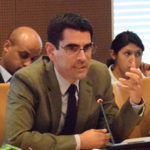
Search
Posts del March, 2017
Seminar focuses on “MPI: its impact on social policy in Colombia”
Then Nemesio Roys presented how the DPS uses the information provided by the MPI to redistribute resources and prioritise social policies at the local level. Also, how the MPI has been calculated with the objective to target multidimensional poor households so that they can get access to strategies to reduce poverty in Colombia.
After this presentation a panel of experts took place. The panellists included Mauricio Perfetti, Luis Fernando Mejia, Nemesio Roys and Roberto Angulo. Sabina Alkire was the moderator. The panel started with the intervention of Mauricio Perfetti, who discussed how the process of calculating the MPI has been and how transparency plays a major role. He mentioned the existence of an experts committee, which has a main task to validate the methodology and to guarantee the transparency of the figures.
In addition, Perfetti mentioned the importance of having a multidimensional poverty measure at the international level. In this context, Colombia is one of the few countries to have presented a report were the MPI was explicitly mentioned as a tool to monitor social policy to fulfil the Sustainable Development Goals. The next panellist was Luis Fernando Mejía, who presented how the MPI has been articulated to the National Development Plan and is an instrument to facilitate the design of social policies in Colombia. He also mentioned some of the challenges that the MPI has had in the country, some of which are related to the representativeness of the results and how it does not reveal what happens at the local level. As a consequence the DNP has calculated an MPI using data from the SISBEN (survey to targeting beneficiaries of social programmes).

The presentation of Nemesio Roys highlighted how Colombia has used the MPI to design programmes to respond to the specific needs of the population, he also emphasised the need for the MPI to be calculated over time and be resistant to changes in government.
Finally Roberto Angulo discussed some of the reasons why the MPI in Colombia has had a positive effect on social policy, and this is mainly by the inclusion of the MPI in the National Development Plan. Angulo also mentioned how effective Colombia has been in the reduction of multidimensional poverty and that the MPI has facilitated the design of policies that aim to reduce poverty in different dimensional aspects that has improved the work between various public sectors.
Watch a video on the seminar (in Spanish)
Panama approves plan for National MPI
The Government with OPHI assistance has been working on this national MPI since last year. Professionals from different offices and Ministries of the Government have been trained by OPHI. Data for the MPI will be collected by the National Institute of Statistics and the data analyzed by the Ministry of Economy and Finance. The Ministry of Social Development has led this whole project and acts as coordinator of the Social Cabinet of Panama.
On March 15th, the Social Cabinet approved the dimensions and indicators of the Panama MPI. John Hammock of OPHI was able to be present for both these important meetings that help establish the MPI as an official measure of poverty to complement the existing income measure.
2017 UNSC | MPPN Side Event at United Nations Statistical Commission 48th Session
 Attila Hancioglu, Global MICS Coordinator, UNICEF
Attila Hancioglu, Global MICS Coordinator, UNICEF
“Recently, of course, as a result of all our efforts, we were pleased to see that multidimensional poverty has taken its deserved place in the SDG framework.” Hancioglu provided the welcome news that due to the mainstreaming of MPI it would be included as a standard part of MICS survey reports together with child poverty indicators.
“Our work is going to intensify in general. We are very pleased to have seen specifically on MPI a number of child-specific MPIs in a number of countries, including Malaysia, Vietnam, El Salvador, and Rwanda. And including the report, which was released last year, for Bhutan on a child-specific MPI”.
 Xavier Mancero – Senior Statistician, Economic Commission for Latin America and the Caribbean
Xavier Mancero – Senior Statistician, Economic Commission for Latin America and the Caribbean
Mancero presented a new project they have jointly with UNESCWA and other UN agencies and the Secretariat, in which one component will address multidimensional poverty and proposing new questions to address common challenges in household data sources for MPIs. He observed “what we see is we already have the support to build a National MPI, but then we are very limited usually by the data we have in the household surveys. So, we have indicators of access and not quality… Or there are dimensions of poverty that are not considered in these surveys.” The fundamental question they face is this: “Now that we have the multidimensional poverty index, how do we measure it better? How do we measure the dimensions that are lacking or come closer to what we want to know about the poor population?”
— — — — — — — —
About National and Global MPIs:
Governments such as Mexico, Colombia, Bhutan, Chile, Costa Rica, El Salvador, Ecuador, Honduras, Pakistan and Armenia use official multidimensional poverty indices (MPIs) as an official statistic of poverty. Each national MPI is tailor-made to the national context. For example, its design may reflect the constitution, or national development plan, or a participatory exploration of what poverty means. The national MPI may be computed using the same survey as income poverty metrics, or a different survey. It may be updated annually or every 2 years. Each national MPI is an official poverty statistic, but an effort is made so that it is used to inform and energise policy.
Yet not all governments have national MPIs. Even when they do, national MPIs cannot be compared. So there is a value-added to having a comparable global MPI across developing countries and/or universally, with extensive and disaggregated information on the composition of poverty for different groups. A global MPI for developing countries has been estimated by OPHI and the UNDP’s Human Development Report Office, and disaggregated for 1,300 subnational regions, as well as by variables like age and rural-urban areas. The global MPI might be particularly useful for SDG target 1.2 of halving multidimensional poverty, and potentially by countries without tailor-made National MPIs at the present time.
About the Multidimensional Poverty Peer Network (MPPN):
This event was co-hosted by the Multidimensional Poverty Peer Network (MPPN), a group of senior representatives from over 50 governments and international institutions, and its Secretariat, OPHI.
The Multidimensional Poverty Peer Network was launched in June 2013 at a distinguished event at the University of Oxford, at which President Juan Manuel Santos of Colombia and Professor Amartya Sen gave keynote addresses. The network was established in response to demand for information on implementing multidimensional measures, and for technical and institutional support. The Network Steering Committee includes Ministers and senior government officials from China, South Africa, Mexico, and Colombia as well as from OPHI.
Important Info:
- Presentations and remarks
- Photos
- Agenda
- Where: United Nations, New York
- When: Tuesday, 7 March 2017
- Hashtag: #UN48SC #UNStats
- Website













Recent Comments